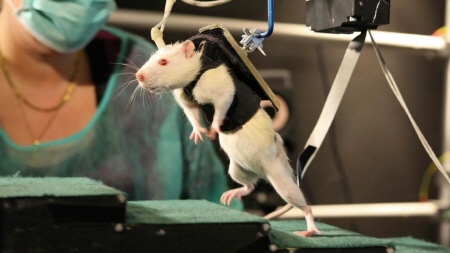
   |
[Headlines] (HL-의학/건강/운동) Stem Cells Help Paralyzed Mice Walk
최고관리자 | 18-04-17 23:09

A group of scientists in Israel are researching how to help paralyzed people walk again. They are using human stem cells to repair the spinal cords of mice. The results sound like a miracle. The researchers put human stem cells in mice with severed spinal cords. About six weeks after the surgery, some of the mice were able to walk. Shulamit Levenberg is a researcher at the Israel Institute of Technology. She explains how she and other researchers were able to create spinal cord recovery. "In this project we managed to induce spinal cord regeneration following complete injury to the spinal cord, and this was to the extent where the animal that was totally paralyzed started to walk again and also regained sensory perception. And this was really amazing – to see the animals walk after two, three weeks.” The work involved more than simply inserting stem cells in the spinal cord. The research team also built a structure that provided an environment in which the stem cells could attach and grow into support cells. The spinal cord cannot repair itself. So, this engineered tissue supported neurons in the spinal cords of the mice.
* paralyzed = 마비된/ stem cell = 줄기 세포/ repair = 수리[보수/수선]하다; 바로잡다/ spinal cord = 척수, 등골/ sever = (두 조각으로) 자르다[절단하다]; 잘라 내다/ induce = 유발[초래]하다; 설득하다, 유도하다/ regeneration = (생물·전자) 재생; (정신적·도덕적인) 갱생, 신생; 재건, 부흥, 부활/ to the extent = ~할 정도까지; ~한 결과로; ~의 범위에서/ regain = (특히 능력・특질 등을) 되찾다[회복하다]/ sensory perception = 감각지각/ grow into ~ = 자라서 ~이 되다/ support cell = 버팀세포/ engineered = (유전자가) 조작된/ neuron = (생물) 뉴런, 신경 세포
Daniel Offen is a professor at Tel Aviv University. He explains more fully. "We know that spinal cord cannot recover by itself. So what we tried to do is to take stem cells -- actually we took it from human -- and transplant it inside the spinal cord." Every year, between 250,000 and 500,000 people around the world suffer a spinal cord injury. Those numbers come from a 2013 report by the World Health Organization. People who suffer spinal cord injuries often receive therapy and different kinds of treatments. However, recovery is difficult and extremely rare. But Levenberg says she is hopeful that their research will one day be able to help humans. But, she adds, these are "very early studies." "The hope is that we will be able to get similar results in humans, meaning that there will be ... we will be able to see regeneration and we will be able to see some behavioral improvement, but of course these are very early studies and we still do not know how it will work in humans." Only about 40 percent of the mice that received the stem cell transplants were able to support weight on their back legs and walk. The researchers say their hope is that these kinds of stem cell transplants will one day be a part of every hospital's procedures.
* transplant = (생체의 조직 등을) 이식하다/ recovery = (건강) 회복/ behavioral improvement = 행동 향상/ procedure = (의학) 수술; (특히 어떤 일을 늘・제대로 하는) 절차[방법]
   |




